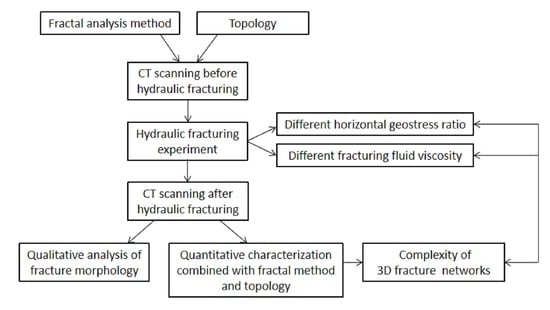Fractal Characterization of Complex Hydraulic Fractures in Oil Shale via Topology
Abstract
1. Introduction
2. Materials and Methods
2.1. Sample Preparation
2.2. Experimental Scheme
2.3. Experimental Apparatus and Procedure
- All the samples were scanned before fracturing so that the further development of the natural fractures could be discussed.
- After sealing the wellbore, a sample was placed in the true triaxial hydraulic fracturing experimental apparatus. To avoid damage to the samples as the confining pressure was applied, the stresses in the three directions are first loaded to , two are then further loaded to , and one is finally further loaded to .
- Before fracturing, a pressure of 0.5 MPa was applied to the wellbore to check whether the sealed sample would leak. A hydraulic pump was used to load the sample to failure with a flow rate of 0.06 mL/s.
- The shale samples were also scanned after fracturing, and the 3D fracture networks were reconstructed to study the complexity of the fracture network.
2.4. Reconstruction of 3D Fractures
3. Experimental Results and Discussion
3.1. Fractal Method and Network Topology
3.1.1. Fractal Calculation Method
3.1.2. Network Topology
3.1.3. Fractal Character and Topology of Typical Fractures
3.1.4. Fractal Character and Topology of Fracture Network after Fracturing
3.2. Effect of the Horizontal Stress Ratio on the Complexity of Fracture Networks
3.3. Effect of Fluid Viscosity on the Fractal Dimension and Complexity of Fracture Networks
4. Conclusions
- According to the results of fracture plane combination models, the fractal dimension cannot accurately characterize the complexity of fracture networks. The method based on the fractal theory and topology can more effectively characterize the complexity of the fracture network.
- Different horizontal stress ratios change the fractal dimension of the fracture network at a rate of 0.45–2.58%, in which a greater horizontal stress ratio tends to correspond to a lower change rate, and vice versa. Under different horizontal stress ratios, DNH is 1.9522–2.1289 and CB is 1.57–2.00, and the complexities of fracture networks after fracturing can be divided into four levels. The result shows that complex fracture networks are more easily formed under a lower horizontal stress ratio.
- Under different fluid viscosities, the fractal dimensions of fracture networks have a change rate of 1.50–3.64%, where a transition emerges at the fluid viscosity of 5.0 mPa·s. After fracturing, DNH is 2.0810–2.1837 and CB is 1.57 to 1.81. Similarly, the complexities of fracture networks after fracturing can be divided into four levels. A complex fracture network tends to be stimulated under the conditions of a low fluid viscosity: The fluid viscosity must not be too low or too high.
Author Contributions
Funding
Conflicts of Interest
References
- Liu, J.; Xie, L.; Yao, Y.; Gan, Q.; Zhao, P.; Du, L. Preliminary Study of Influence Factors and Estimation Model of the Enhanced Gas Recovery Stimulated by Carbon Dioxide Utilization in Shale. ACS Sustain. Chem. Eng. 2019, 7, 20114–20125. [Google Scholar] [CrossRef]
- Zhao, W.; Hu, S.; Hou, L.; Yang, T.; Li, X.; Guo, B.; Yang, Z. Types and resource potential of continental shale oil in China and its boundary with tight oil. Pet. Explor. Dev. 2020, 47, 1–11. [Google Scholar] [CrossRef]
- Advanced Resources International, Inc. EIA/ARI World Shale Gas and Shale Oil Resource Assessment; Advanced Resources International, Inc.: Arlington, MA, USA, 2013. [Google Scholar]
- Java Javadpour, F.; McClure, M.; Naraghi, M. Slip-corrected liquid permeability and its effect on hydraulic fracturing and fluid loss in shale. Fuel 2015, 160, 549–559. [Google Scholar] [CrossRef]
- Zhou, T.; Zhang, S.; Yang, L.; Ma, X.; Zou, Y.; Lin, H. Experimental investigation on fracture surface strength softening induced by fracturing fluid imbibition and its impacts on flow conductivity in shale reservoirs. J. Nat. Gas Sci. Eng. 2016, 36, 893–905. [Google Scholar] [CrossRef]
- Liu, J.; Xie, L.; Elsworth, D.; Gan, Q. CO2/CH4 Competitive Adsorption in Shale: Implications for Enhancement in Gas Production and Reduction in Carbon Emissions. Environ. Sci. Technol. 2019, 53, 9328–9336. [Google Scholar] [CrossRef]
- Liu, L.; Zhu, W.; Wei, C.; Elsworth, D.; Wang, J. Microcrack-based geomechanical modeling of rock-gas interaction during supercritical CO2 fracturing. J. Pet. Sci. Eng. 2018, 164, 91–102. [Google Scholar] [CrossRef]
- Zu Zuloaga-Molero, P.; Yu, W.; Xu, Y.; Sepehrnoori, K.; Li, B. Simulation Study of CO2-EOR in Tight Oil Reservoirs with Complex Fracture Geometries. Sci. Rep. 2016, 6, 33445. [Google Scholar] [CrossRef]
- Zhou, J.; Jin, Y.; Chen, M. Experimental investigation of hydraulic fracturing in random naturally fractured blocks. Int. J. Rock Mech. Min. Sci. 2010, 47, 1193–1199. [Google Scholar] [CrossRef]
- Zhou, J.; Chen, M.; Jin, Y.; Zhang, G.-Q. Analysis of fracture propagation behavior and fracture geometry using a tri-axial fracturing system in naturally fractured reservoirs. Int. J. Rock Mech. Min. Sci. 2008, 45, 1143–1152. [Google Scholar] [CrossRef]
- Yao, F.; Chen, M.; Wu, X.D.; Zhang, G. Physical simulation of hydraulic fracture propagation in naturally fractured formations. Oil Drill. Prod. Technol. 2008, 30, 83–86. [Google Scholar] [CrossRef][Green Version]
- Meng, Q.M.; Zhang, S.C.; Guo, X.M.; Chen, X.H.; Zhang, Y. A primary investigation on propagation mechanism for hydraulic fracture in glutenite formation. J. Oil Gas Technol. 2010, 32, 119–123. [Google Scholar]
- Chen, Y.; Nagaya, Y.; Ishida, T. Observations of Fractures Induced by Hydraulic Fracturing in Anisotropic Granite. Rock Mech. Rock Eng. 2015, 48, 1455–1461. [Google Scholar] [CrossRef]
- Maxwell, S.C.; Urbancic, T.I.; Steinsberger, N.; Zinno, R. Microseismic imaging of hydraulic fracture complexity in the Barnett Shale. In Proceedings of the Spe Technical Conference & Exhibition, San Antonio, TX, USA, 29 September–2 October 2002. [Google Scholar]
- Bunger, A.P.; Kear, J.; Dyskin, A.V.; Pasternak, E. Sustained acoustic emissions following tensile crack propagation in a crystalline rock. Int. J. Fract. 2015, 193, 87–98. [Google Scholar] [CrossRef]
- Chen, L.-H.; Chen, W.-C.; Chen, Y.-C.; Benyamin, L.; Li, A.-J. Investigation of Hydraulic Fracture Propagation Using a Post-Peak Control System Coupled with Acoustic Emission. Rock Mech. Rock Eng. 2014, 48, 1233–1248. [Google Scholar] [CrossRef]
- Li, D.; Kuang, K.S.C.; Koh, C.G. Fatigue crack sizing in rail steel using crack closure-induced acoustic emission waves. Meas. Sci. Technol. 2017, 28, 065601. [Google Scholar] [CrossRef]
- Heng, S.; Yang, C.H.; Zeng, Y.J.; Guo, Y.T.; Hou, Z.K. Experimental study on hydraulic fracture geometry of shale. Chin. J. Geotech. Eng. 2014, 36, 1243–1251. [Google Scholar] [CrossRef]
- Ma, X.; Li, N.; Yin, C.; Li, Y.; Zou, Y.; Wu, S.; He, F.; Wang, X.; Zhou, T. Hydraulic fracture propagation geometry and acoustic emission interpretation: A case study of Silurian Longmaxi Formation shale in Sichuan Basin, SW China. Pet. Explor. Dev. 2017, 44, 1030–1037. [Google Scholar] [CrossRef]
- Zhang, S.C.; Gou, T.K.; Zhou, T.; Zou, Y.S.; Mu, S. Fracture propagation mechanism experiment of hydraulic fracturing in natural shale. Acta Pet. Sin. 2014, 35, 496–503. [Google Scholar] [CrossRef]
- Bohloli, B.; De Pater, C. Experimental study on hydraulic fracturing of soft rocks: Influence of fluid rheology and confining stress. J. Pet. Sci. Eng. 2006, 53, 1–12. [Google Scholar] [CrossRef]
- Dong, Y.; Pater, C.J. Observation and modeling of the hydraulic fracture tip in sand. In Proceedings of the 42nd US Rock Mechanics Symposium (USRMS), San Francisco, CA, USA, 29 June–2 July 2008. [Google Scholar]
- Sun, Z.Y.; Huang, Z.W.; Liu, C.Y.; Wu, C. Experimental research on hydraulic fracture initiation and propagation by CT scanning. In Proceedings of the Field Exploration & Development Conference, Chengdu, China, 23–25 September 2020. [Google Scholar]
- Guo, T.; Zhang, S.; Qu, Z.; Zhou, T.; Xiao, Y.; Gao, J. Experimental study of hydraulic fracturing for shale by stimulated reservoir volume. Fuel 2014, 128, 373–380. [Google Scholar] [CrossRef]
- Karpyn, Z.; Alajmi, A.; Radaelli, F.; Halleck, P.; Grader, A. X-ray CT and hydraulic evidence for a relationship between fracture conductivity and adjacent matrix porosity. Eng. Geol. 2009, 103, 139–145. [Google Scholar] [CrossRef]
- Zhang, X.; Lu, Y.; Tang, J.; Zhou, Z.; Liao, Y. Experimental study on fracture initiation and propagation in shale using supercritical carbon dioxide fracturing. Fuel 2017, 190, 370–378. [Google Scholar] [CrossRef]
- He, J.; Lin, C.; Li, X.; Zhang, Y.; Chen, Y. Initiation, propagation, closure and morphology of hydraulic fractures in sandstone cores. Fuel 2017, 208, 65–70. [Google Scholar] [CrossRef]
- Li, Z.; Jia, C.; Yang, C.; Zeng, Y.; ShuaI, H.; Wang, L.; Hou, Z. Propagation of hydraulic fissures and bedding planes in hydraulic fracturing of shale. Chin. J. Rock. Mech. Eng. 2015, 34, 12–20. [Google Scholar] [CrossRef]
- Mohmadi, M.; Wan, R.G. Strength and post-peak response of Colorado shale at high pressure and temperature. Int. J. Rock Mech. Min. Sci. 2016, 84, 34–46. [Google Scholar] [CrossRef]
- Jia, L.; Chen, M.; Sun, L.; Sun, Z.; Zhang, W.; Zhu, Q.; Sun, Z.; Jin, Y. Experimental study on propagation of hydraulic fracture in volcanic rocks using industrial CT technology. Pet. Explor. Dev. 2013, 40, 405–408. [Google Scholar] [CrossRef]
- Raynaud, S.; Fabre, D.; Mazerolle, F.; Geraud, Y.; Latiere, H. Analysis of the internal structure of rocks and characterization of mechanical deformation by a non-destructive method: X-ray tomodensitometry. Tectonophysics 1989, 159, 149–159. [Google Scholar] [CrossRef]
- Jiang, C.; Niu, B.; Yin, G.; Zhang, D.; Yu, T.; Wang, P. CT-based 3D reconstruction of the geometry and propagation of hydraulic fracturing in shale. J. Pet. Sci. Eng. 2019, 179, 899–911. [Google Scholar] [CrossRef]
- Liu, P.; Ju, Y.; Gao, F.; Ranjith, P.G.; Zhang, Q. CT Identification and Fractal Characterization of 3-D Propagation and Distribution of Hydrofracturing Cracks in Low-Permeability Heterogeneous Rocks. J. Geophys. Res. Solid Earth 2018, 123, 2156–2173. [Google Scholar] [CrossRef]
- Zhao, X.; Rui, Z.; Liao, X.; Zhang, R. The qualitative and quantitative fracture evaluation methodology in shale gas reservoir. J. Nat. Gas Sci. Eng. 2015, 27, 486–495. [Google Scholar] [CrossRef]
- Tang, C. Progress in Fracture Characterization and Prediction. Sci. Technol. Rev. 2013, 31, 74–79. [Google Scholar]
- Sanderson, D.J.; Nixon, C.W. The use of topology in fracture network characterization. J. Struct. Geol. 2015, 72, 55–66. [Google Scholar] [CrossRef]
- Cardona, R.; Jenner, E.; Davis, T.L. Fracture network characterization from P- and S-wave data at Weyburn field, Canada. SEG Tech. Program. Expand. Abstr. 2003, 2003, 370–373. [Google Scholar]
- Feng, J.; Yu, J.Y. Determination fractal dimension of soil macropore using computed Tomography. J. Irrig. Drain. 2005, 24, 26–28. [Google Scholar]
- Williams, J.K.; Dawe, R.A. Fractals? An overview of potential applications to transport in porous media. Transp. Porous Media 1986, 1, 201–209. [Google Scholar] [CrossRef]
- Adle, P.M. Transport Processes in Porous Media; Springer: Dordrecht, The Netherlands, 1993. [Google Scholar]
- Sahimi, M.; Yortsos, Y.C. Applications of fractal geometry to porous media: A review. Fluid Dyn. 1992, 27, 824–833. [Google Scholar]
- Sahimi, M. Flow phenomena in rocks: From continuum models to fractals, percolation, cellular automata, and simulated annealing. Rev. Mod. Phys. 1993, 65, 1393–1534. [Google Scholar] [CrossRef]
- Chilingarian, G.V.; Mazzullo, J. Carbonate Reservoir Characterization: A Geologic- Engineering Analysis, Part II: A Geologic-Engineering Analysis; Elsevier: Amsterdam, The Netherlands, 1992. [Google Scholar]
- Xie, H.P. Fractal Geometry and Its Application to Rock and Soil Materials. Chin. J. Geotech. Eng. 1992, 2016, 14–24. [Google Scholar]
- Fu, X.; Qin, Y.; Zhang, W.; Wei, C.; Zhou, R. Fractal classification and natural classification of coal pore structure based on migration of coal bed methane. Chin. Sci. Bull. 2005, 50, 66–71. [Google Scholar] [CrossRef]
- Peng, R.; Yang, Y.; Ju, Y.; Mao, L.; Yang, Y. Computation of fractal dimension of rock pores based on gray CT images. Chin. Sci. Bull. 2011, 56, 3346–3357. [Google Scholar] [CrossRef]
- Cao, T.T.; Song, Z.G.; Wang, S.B.; Xia, J. Characterization of pore structure and fractal dimension of Paleozoic shales from the northeastern Sichuan Basin, China. J. Nat. Gas Sci. Eng. 2016, 35, 882–895. [Google Scholar] [CrossRef]
- Wu, M.; Liu, J.; Lv, X.; Shi, D.; Zhu, Z. A study on homogenization equations of fractal porous media. J. Geophys. Eng. 2018, 15, 2388–2398. [Google Scholar] [CrossRef]
- Li, T.J.; Wang, Y.H.; Zhang, M.Y.; Lee, K.K.; Tsi, Y.; Tham, L.G. Fractal properties of crack in rock and mechanism of rock-burst. Chin. J. Rock Mech. Eng. 2000, 19, 6–10. [Google Scholar] [CrossRef]
- Li, G.; Zhang, R.; Xu, X.L.; Zhang, Y.F. CT image reconstruction of coal rock three-dimensional fractures and body fractal dimension under triaxial compression test. Rock Soil Mech. 2015, 36, 1633–1642. [Google Scholar] [CrossRef]
- Ma, T.; Ma, D.; Yang, Y. Fractal Characteristics of Coal and Sandstone Failure under Different Unloading Confining Pressure Tests. Adv. Mater. Sci. Eng. 2020, 2020, 1–11. [Google Scholar] [CrossRef]
- Ju, Y.; Xi, C.; Zhang, Y.; Mao, L.; Gao, F.; Xie, H. Laboratory in Situ CT Observation of the Evolution of 3D Fracture Networks in Coal Subjected to Confining Pressures and Axial Compressive Loads: A Novel Approach. Rock Mech. Rock Eng. 2018, 51, 3361–3375. [Google Scholar] [CrossRef]
- Zhao, X.P.; Pei, J.L.; Dai, F.; JIN, W.C.; Li, Y.C. Fractal description of cracks in rock mass. J. Sichuan Univ. 2014, 46, 95–100. [Google Scholar]
- Liu, P.; Ju, Y.; Ranjith, P.G.; Zheng, Z.; Chen, J. Experimental investigation of the effects of heterogeneity and geostress difference on the 3D growth and distribution of hydrofracturing cracks in unconventional reservoir rocks. J. Nat. Gas Sci. Eng. 2016, 35, 541–554. [Google Scholar] [CrossRef]
- Ravasz, E.; Barabási, A.-L. Hierarchical organization in complex networks. Phys. Rev. E 2003, 67, 026112. [Google Scholar] [CrossRef] [PubMed]
- Boccaletti, S.; Latora, V.; Moreno, Y.; Chavez, M.; Hwang, D. Complex networks: Structure and dynamics. Phys. Rep. 2006, 424, 175–308. [Google Scholar] [CrossRef]
- Latora, V.; Marchiori, M. Is the Boston subway a small-world network? Phys. A Stat. Mech. Its Appl. 2002, 314, 109–113. [Google Scholar] [CrossRef]
- Guo, Q.; Chen, X.; Liuzhuang, X.; Yang, Z.; Zheng, M.; Chen, N.; Mi, J. Evaluation method for resource potential of shale oil in the Triassic Yanchang Formation of the Ordos Basin, China. Energy Explor. Exploit. 2020, 38, 841–866. [Google Scholar] [CrossRef]
- Manzocchi, T. The connectivity of two-dimensional networks of spatially correlated fractures. Water Resour. Res. 2002, 38, 1. [Google Scholar] [CrossRef]
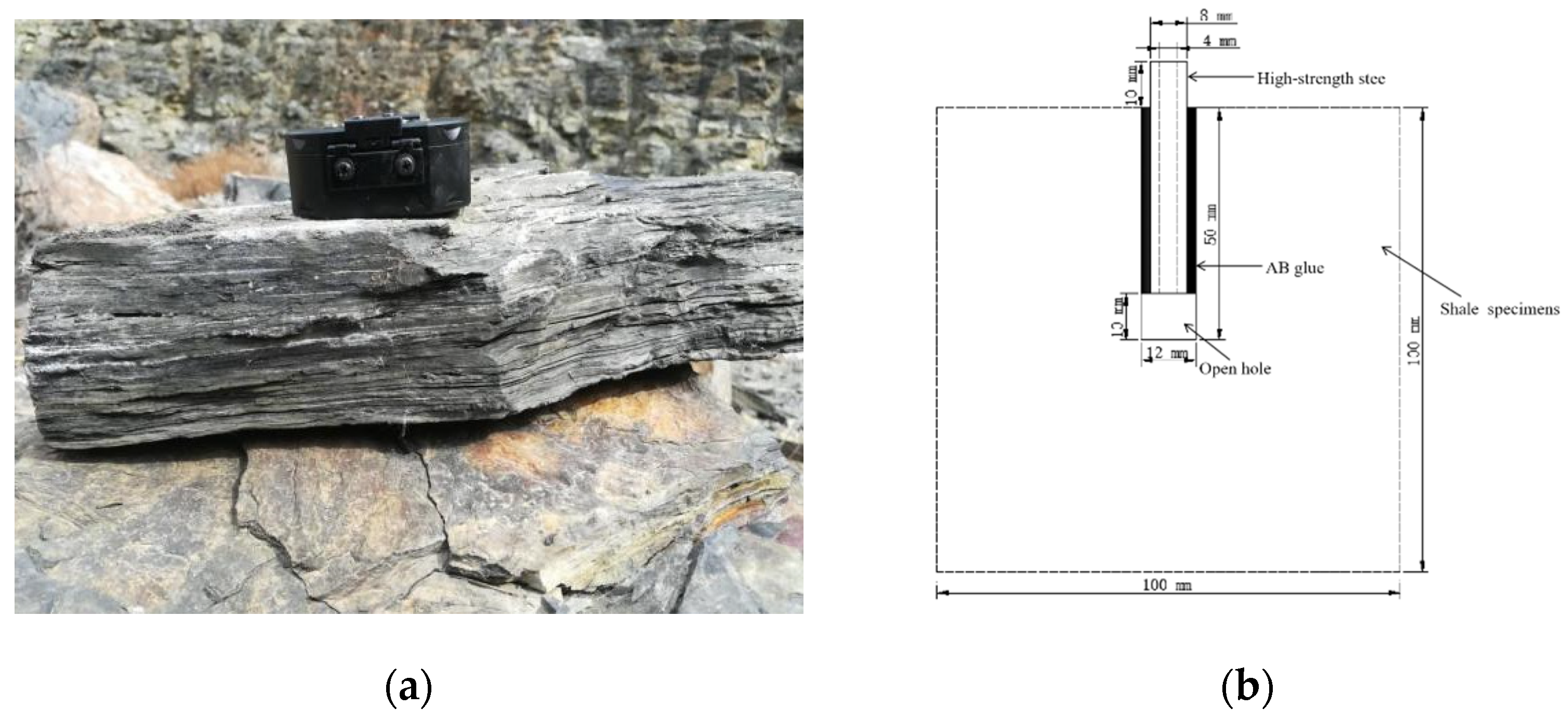

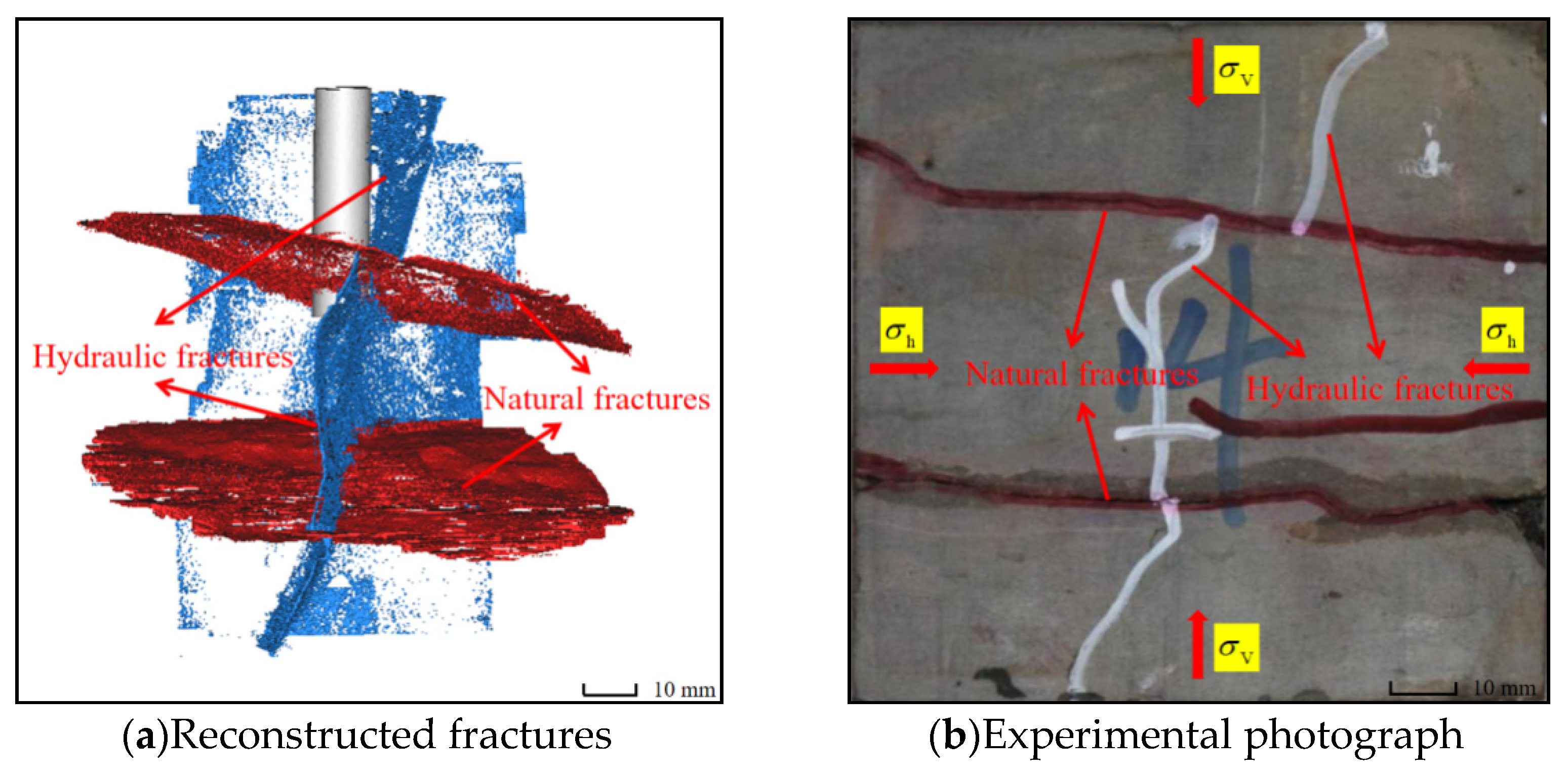

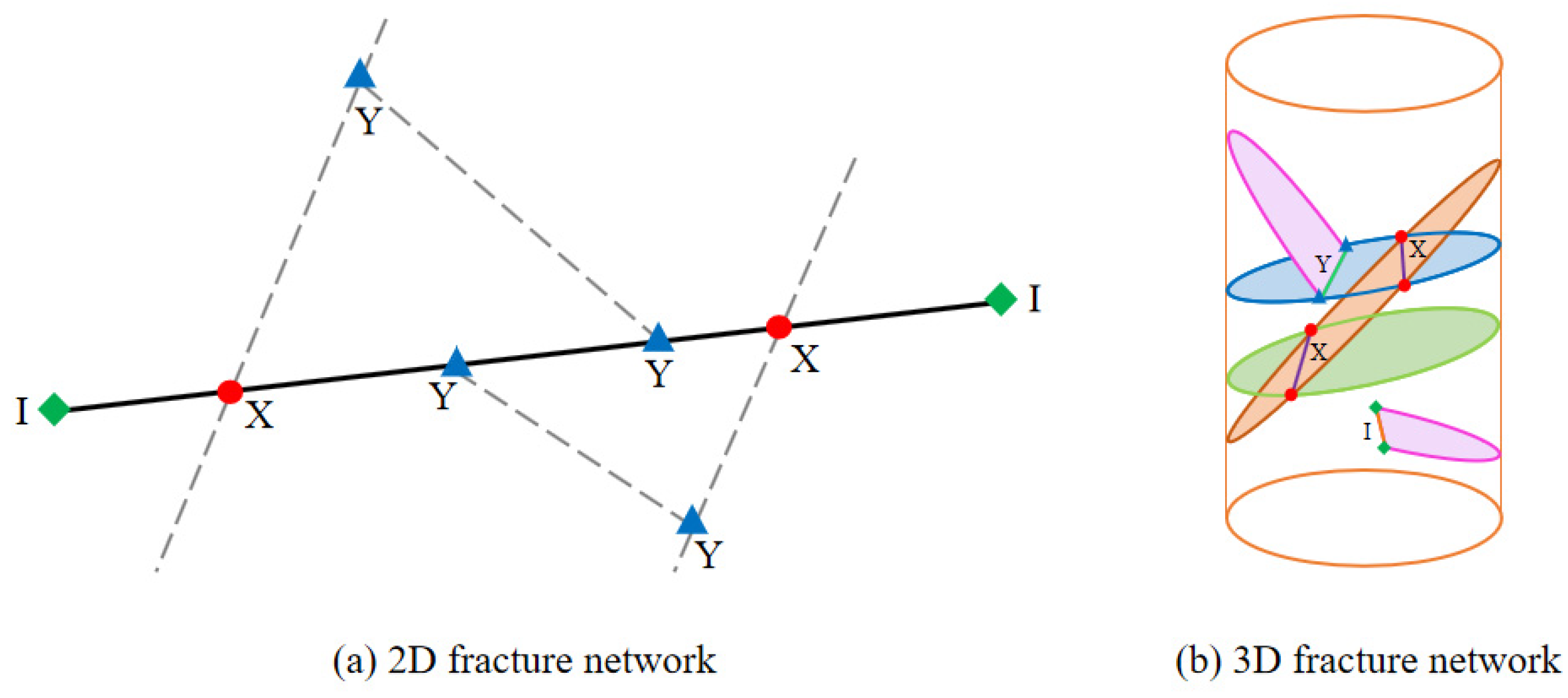
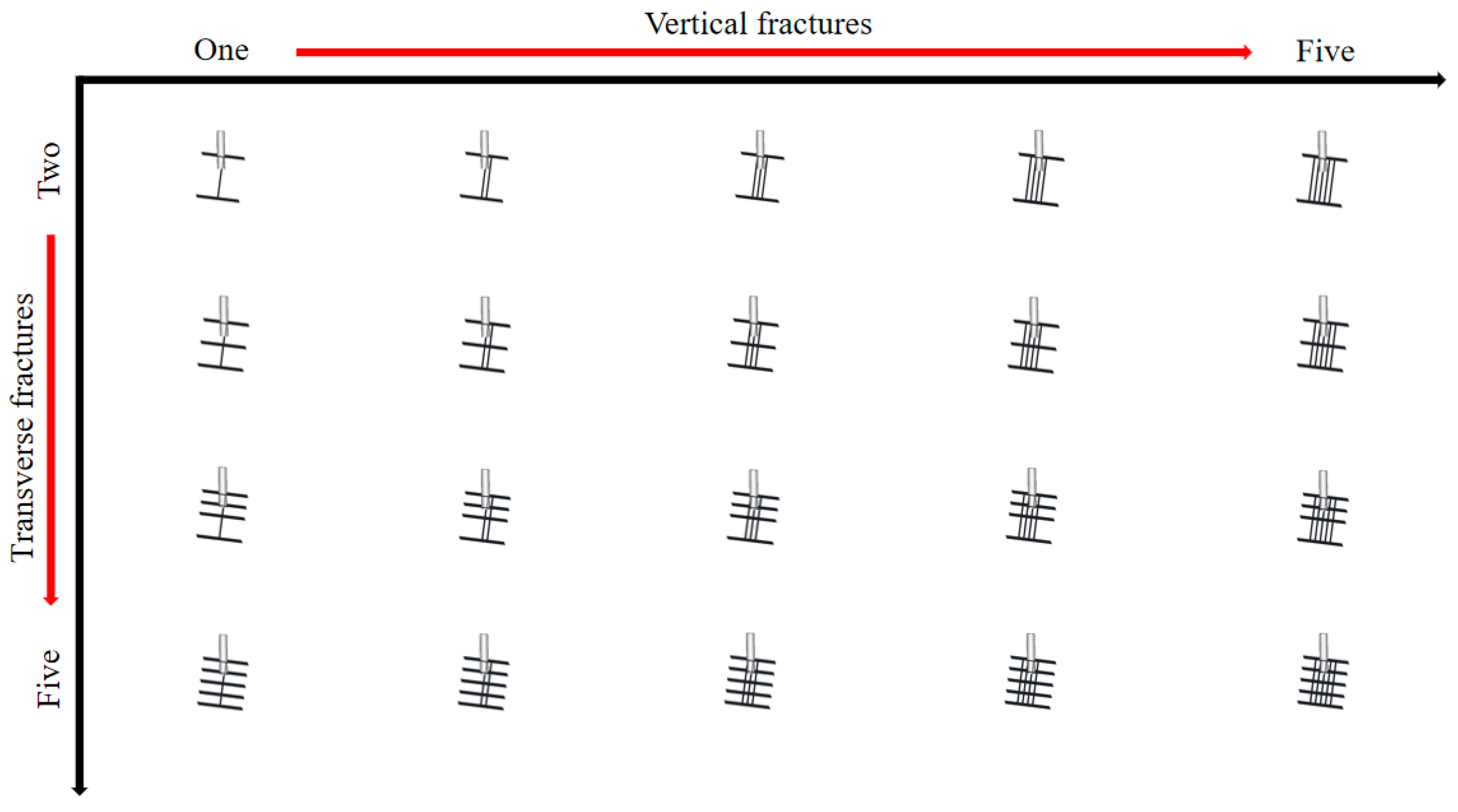
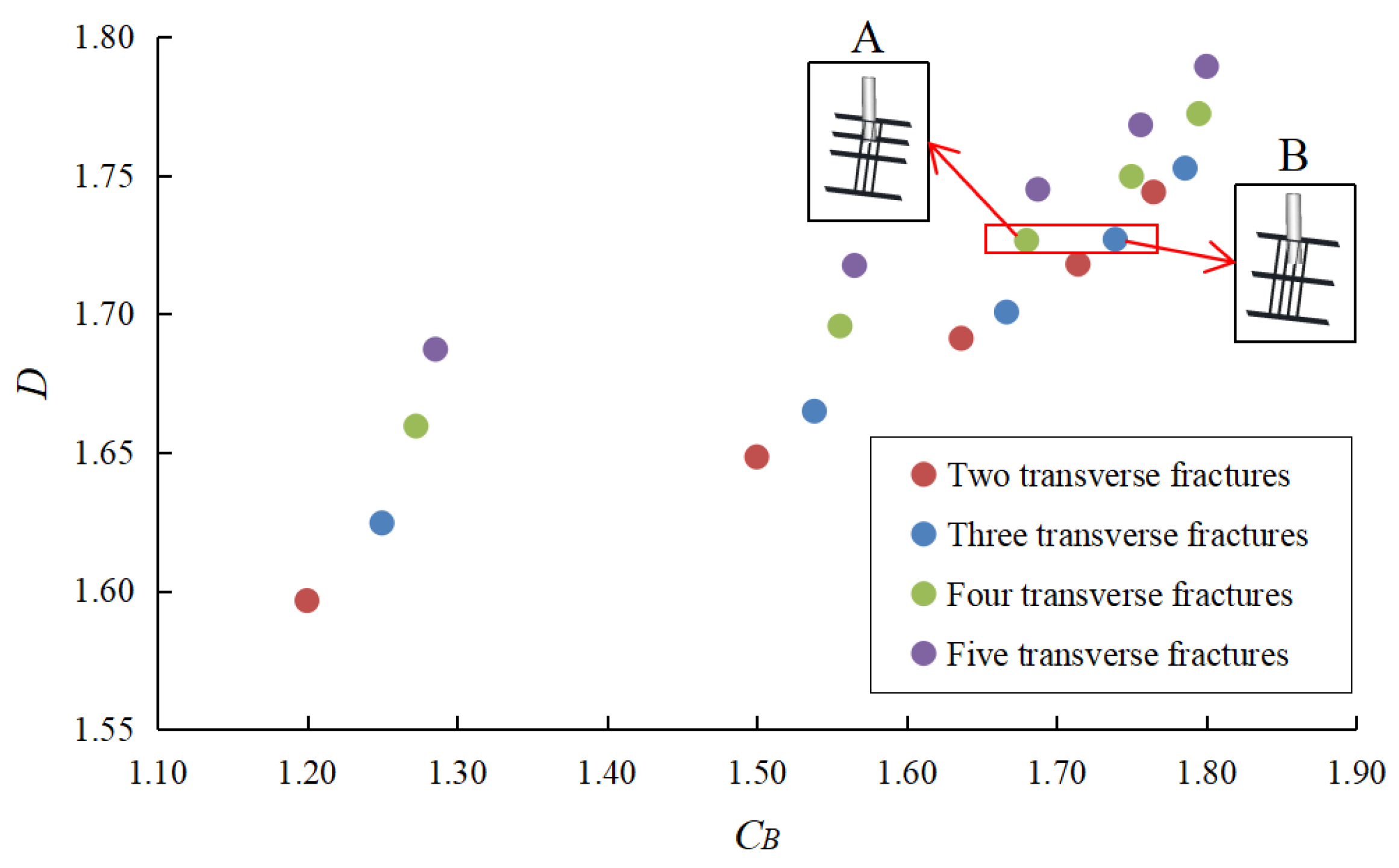
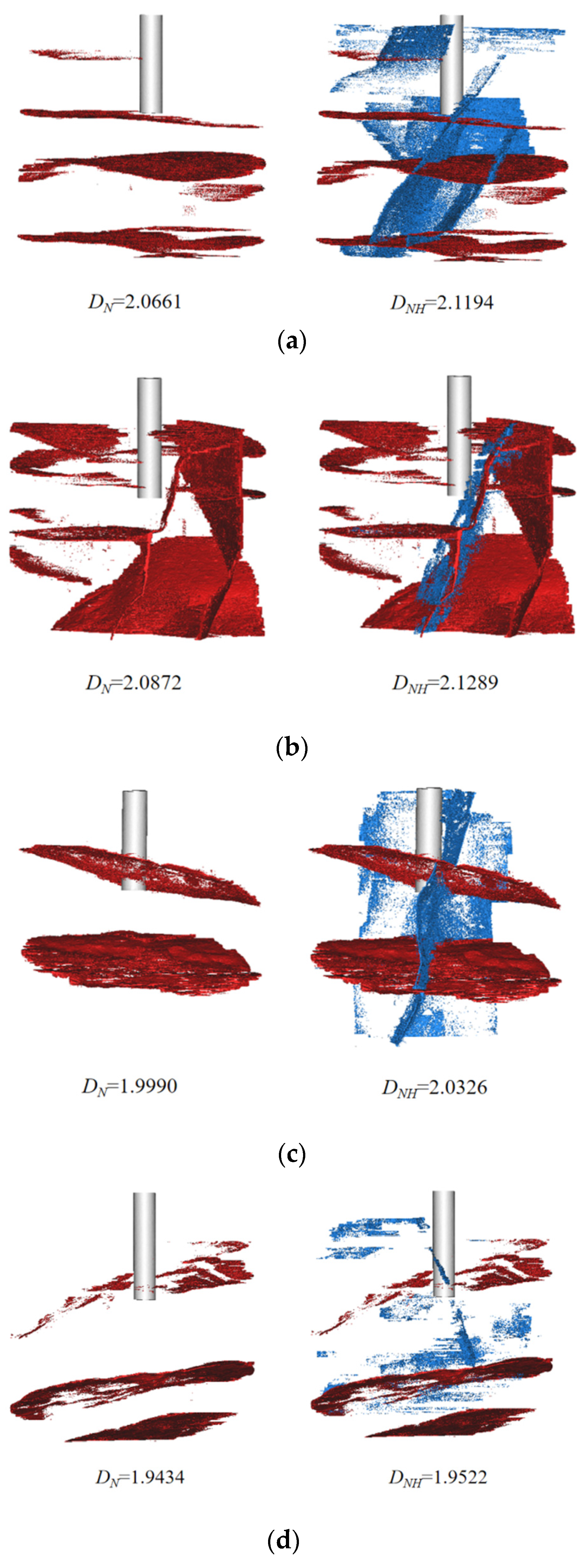
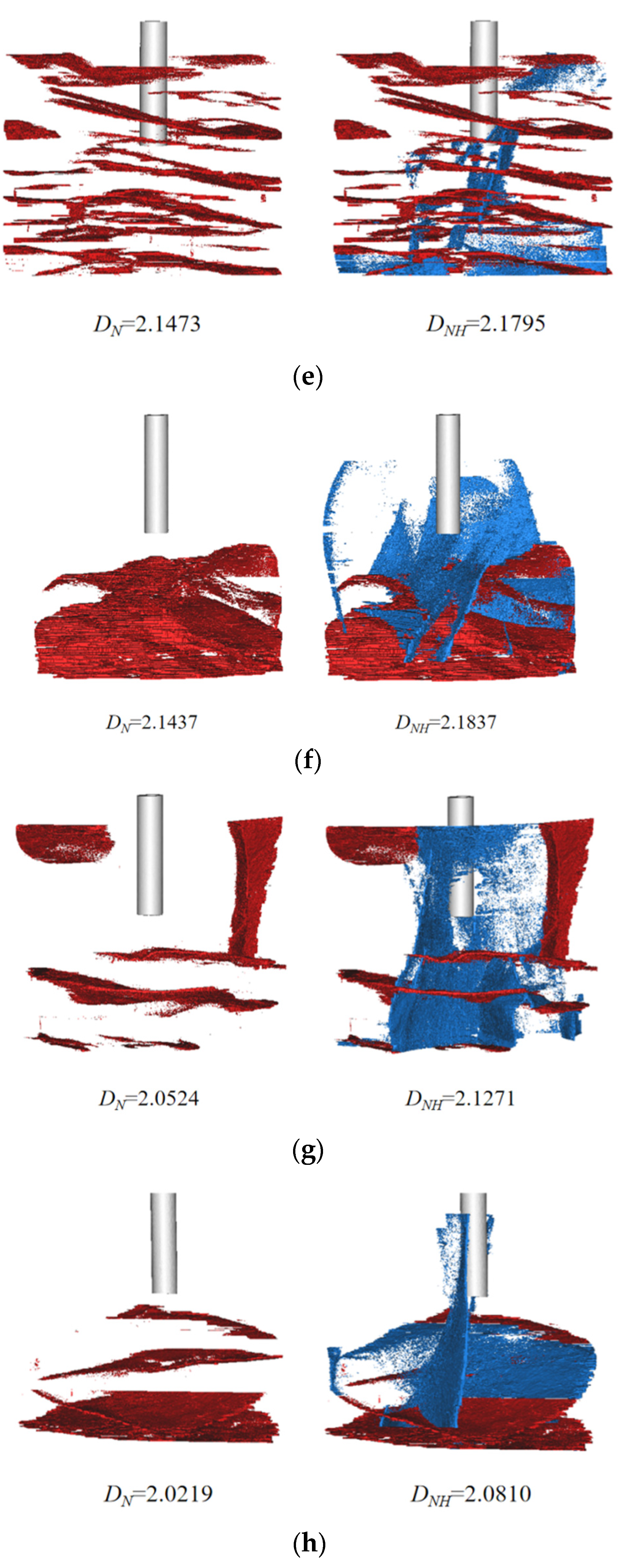
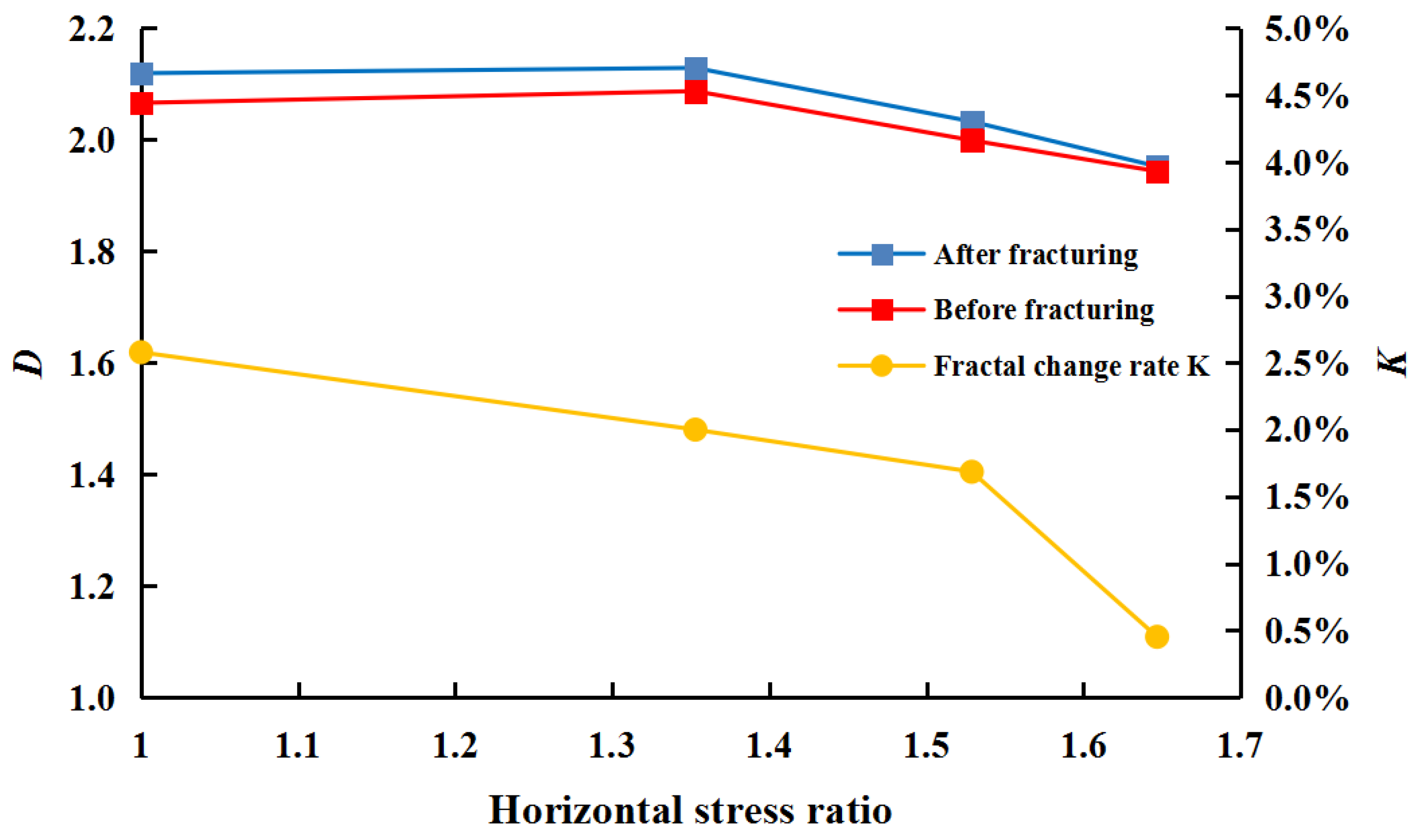
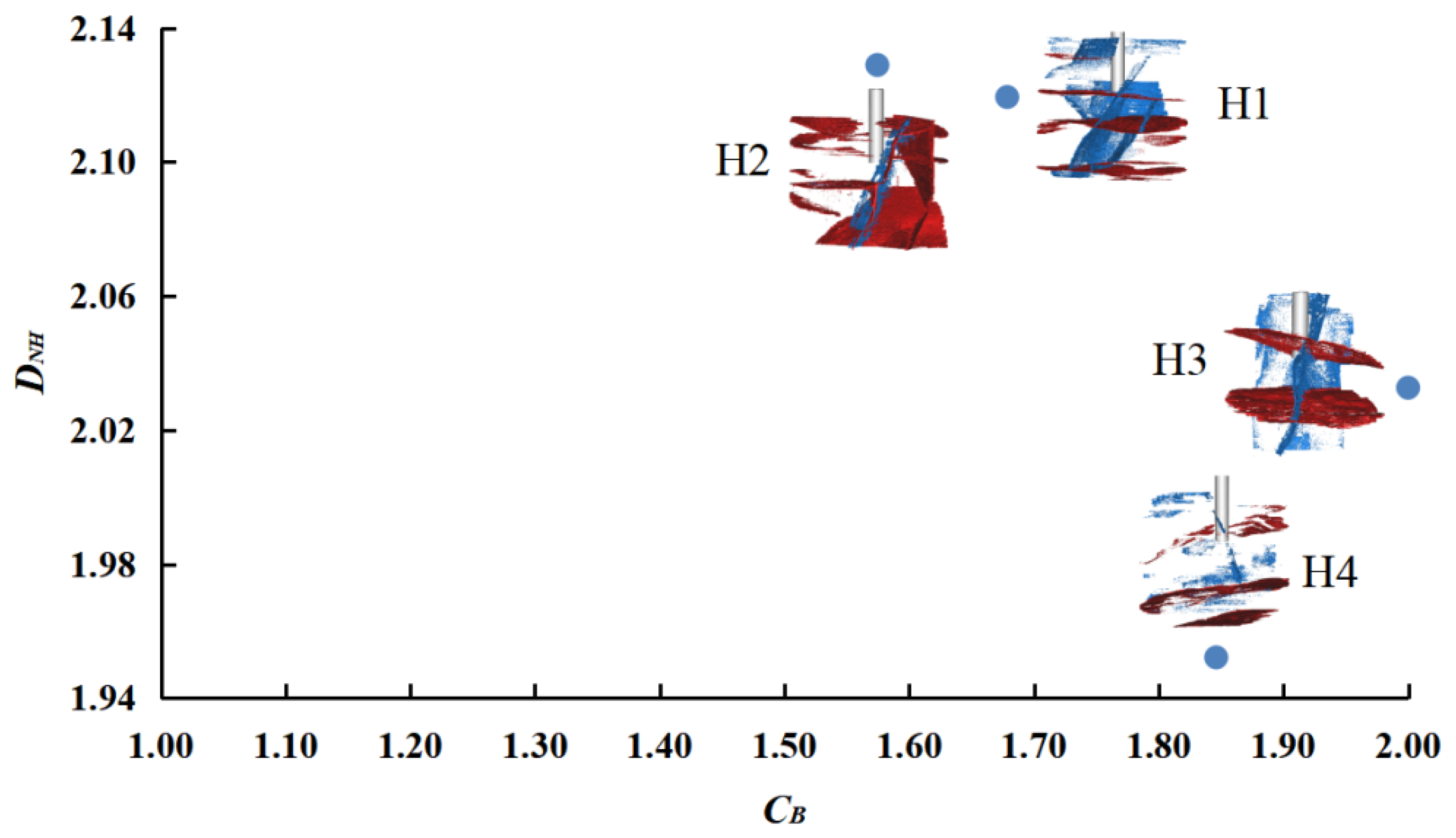
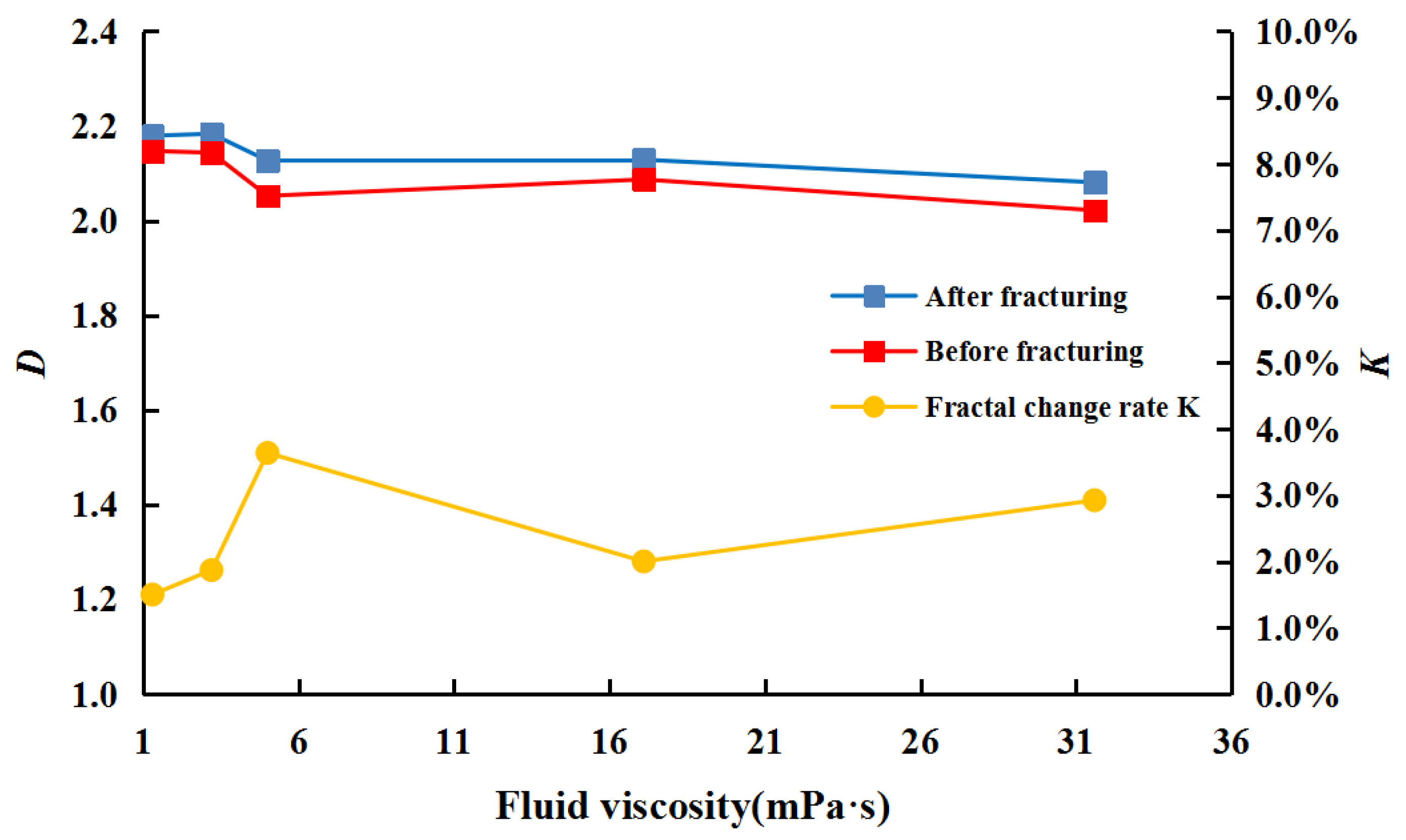
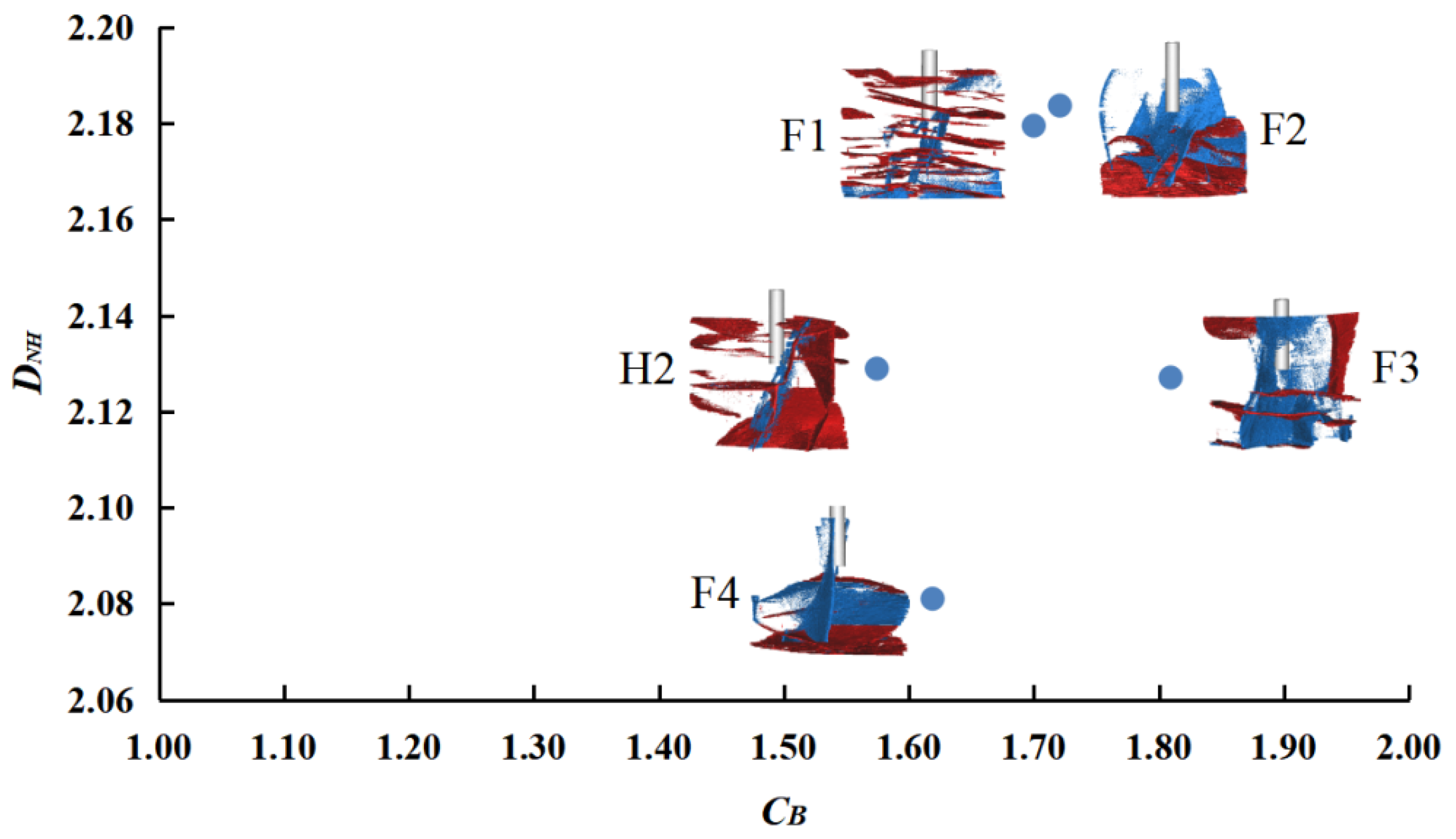
| Test Number | Mineral Content (%) | |||||||
|---|---|---|---|---|---|---|---|---|
| Quartz | Potash Feldspar | Plagio-Clase | Dolomite | Pyrite | Clay Minerals | Parank-Erite | Siderite | |
| A | 18.61 | 31.42 | 6.45 | 1.77 | 0.64 | 21.68 | 13.49 | 6.94 |
| B | 20.10 | 31.12 | 5.53 | 0 | 0.63 | 19.75 | 16.53 | 6.34 |
| C | 20.91 | 32.93 | 4.49 | 0 | 0.69 | 20.70 | 13.29 | 6.99 |
| Sample Number | Triaxial Stress (Mpa) (σ1/σ2/σ3) | Horizontal Stress Ratio (σ2/σ3) | Fluid Viscosity (Mpa·S) | Pumping Rate (Ml/S) |
|---|---|---|---|---|
| H1 | 40/24.3/24.3 | 1.000 | 17.1 | 0.06 |
| H2 | 40/33/24.3 | 1.353 | 17.1 | 0.06 |
| H3 | 40/37.2/24.3 | 1.529 | 17.1 | 0.06 |
| H4 | 40/40/24.3 | 1.647 | 17.1 | 0.06 |
| F1 | 40/33/24.3 | 1.353 | 1.3 | 0.06 |
| F2 | 40/33/24.3 | 1.353 | 3.2 | 0.06 |
| F3 | 40/33/24.3 | 1.353 | 5.0 | 0.06 |
| F4 | 40/33/24.3 | 1.353 | 31.6 | 0.06 |
| Sample Number | DN | DNH | K | Number of Nodes | CB | ||
|---|---|---|---|---|---|---|---|
| I | Y | X | |||||
| H1 | 2.0661 | 2.1194 | 2.58% | 9 | 9 | 5 | 1.68 |
| H2 | 2.0872 | 2.1289 | 2.00% | 10 | 7 | 4 | 1.57 |
| H3 | 1.9990 | 2.0326 | 1.68% | 0 | 1 | 4 | 2.00 |
| H4 | 1.9434 | 1.9522 | 0.45% | 2 | 0 | 6 | 1.85 |
| F1 | 2.1473 | 2.1795 | 1.50% | 9 | 9 | 6 | 1.70 |
| F2 | 2.1437 | 2.1837 | 1.87% | 6 | 7 | 4 | 1.72 |
| F3 | 2.0524 | 2.1271 | 3.64% | 4 | 6 | 5 | 1.81 |
| F4 | 2.0219 | 2.0810 | 2.92% | 4 | 3 | 2 | 1.62 |
Publisher’s Note: MDPI stays neutral with regard to jurisdictional claims in published maps and institutional affiliations. |
© 2021 by the authors. Licensee MDPI, Basel, Switzerland. This article is an open access article distributed under the terms and conditions of the Creative Commons Attribution (CC BY) license (http://creativecommons.org/licenses/by/4.0/).
Share and Cite
He, Q.; He, B.; Li, F.; Shi, A.; Chen, J.; Xie, L.; Ning, W. Fractal Characterization of Complex Hydraulic Fractures in Oil Shale via Topology. Energies 2021, 14, 1123. https://doi.org/10.3390/en14041123
He Q, He B, Li F, Shi A, Chen J, Xie L, Ning W. Fractal Characterization of Complex Hydraulic Fractures in Oil Shale via Topology. Energies. 2021; 14(4):1123. https://doi.org/10.3390/en14041123
Chicago/Turabian StyleHe, Qiang, Bo He, Fengxia Li, Aiping Shi, Jiang Chen, Lingzhi Xie, and Wenxiang Ning. 2021. "Fractal Characterization of Complex Hydraulic Fractures in Oil Shale via Topology" Energies 14, no. 4: 1123. https://doi.org/10.3390/en14041123
APA StyleHe, Q., He, B., Li, F., Shi, A., Chen, J., Xie, L., & Ning, W. (2021). Fractal Characterization of Complex Hydraulic Fractures in Oil Shale via Topology. Energies, 14(4), 1123. https://doi.org/10.3390/en14041123




